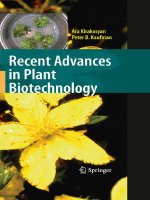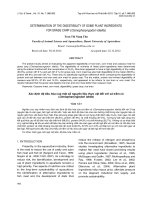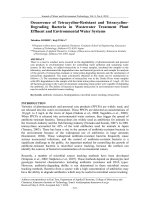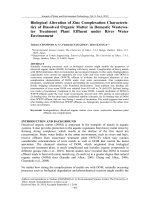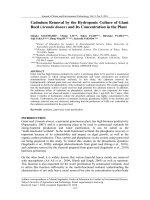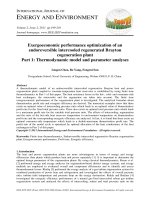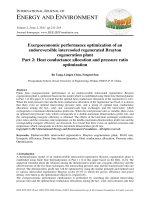Plant biochemistry
Bạn đang xem bản rút gọn của tài liệu. Xem và tải ngay bản đầy đủ của tài liệu tại đây (4.97 MB, 618 trang )
Plant Biochemistry
Fourth edition
Plant
Biochemistry
Hans-Walter Heldt
Birgit Piechulla
in cooperation with Fiona Heldt
Translation of the 4th German edition
AMSTERDAM • BOSTON • HEIDELBERG • LONDON
NEW YORK • OXFORD • PARIS • SAN DIEGO
SAN FRANCISCO • SINGAPORE • SYDNEY • TOKYO
Academic Press is an imprint of Elsevier
Academic Press is an imprint of Elsevier
32 Jamestown Road, London NW1 7BY, UK
30 Corporate Drive, Suite 400, Burlington, MA 01803, USA
525 B Street, Suite 1800, San Diego, CA 92101-4495, USA
Fourth edition 2011
Translation © Elsevier Inc.
Translation from the German language edition:
Pflanzenbiochemie by Hans-Walter Heldt and Birgit Piechulla
Copyright © Spektrum Akademischer Verlag Heidelberg 2008
Spektrum Akademischer Verlag is an imprint of Springer-Verlag GmbH
Springer-Verlag GmbH is a part of Springer ScienceBusiness Media
All Rights Reserved
No part of this publication may be reproduced, stored in a retrieval system
or transmitted in any form or by any means electronic, mechanical, photocopying,
recording or otherwise without the prior written permission of the publisher
Permissions may be sought directly from Elsevier’s Science & Technology Rights
Department in Oxford, UK: phone (44) (0) 1865 843830; fax (44) (0) 1865 853333;
email: Alternatively, visit the Science and Technology Books
website at www.elsevierdirect.com/rights for further information
Notice
No responsibility is assumed by the publisher for any injury and/or damage to persons
or property as a matter of products liability, negligence or otherwise, or from any use or
operation of any methods, products, instructions or ideas contained in the material herein.
Because of rapid advances in the medical sciences, in particular, independent verification of
diagnoses and drug dosages should be made
British Library Cataloguing-in-Publication Data
A catalogue record for this book is available from the British Library
Library of Congress Cataloging-in-Publication Data
A catalog record for this book is available from the Library of Congress
ISBN : 978-0-12-384986-1
For information on all Academic Press publications
visit our website at elsevierdirect.com
Typeset by MPS Limited, a Macmillan Company, Chennai, India
www.macmillansolutions.com
Printed and bound in United States of America
10 11 12 13 14 15
10 9 8 7 6 5 4 3 2 1
Dedicated to my teacher, Martin Klingenberg
Hans–Walter Heldt
Preface
The present textbook is written for students and is the product of more than
three decades of teaching experience. It intends to give a broad but concise
overview of the various aspects of plant biochemistry including molecular
biology. We attached importance to an easily understood description of the
principles of metabolism but also restricted the content in such a way that a
student is not distracted by unnecessary details. In view of the importance
of plant biotechnology, industrial applications of plant biochemistry have
been pointed out, wherever it was appropriate. Thus special attention was
given to the generation and utilization of transgenic plants.
Since there are many excellent textbooks on general biochemistry, we
have deliberately omitted dealing with elements such as the structure and
function of amino acids, carbohydrates and nucleotides, the function of
nucleic acids as carriers of genetic information and the structure and function of proteins and the basis of enzyme catalysis. We have dealt with topics of general biochemistry only when it seemed necessary for enhancing
understanding of the problem in hand. Thus, this book is in the end a compromise between a general and a specialized textbook.
To ensure the continuity of the textbook in the future, Birgit Piechulla
is the second author of this edition. We have both gone over all the chapters in the fourth edition, HWH concentrating especially on Chapters
1–15 and BP on the Chapters 16–22. All the chapters of the book have been
thoroughly revised and incorporate the latest scientific knowledge. Here
are just a few examples: the descriptions of the metabolite transport and
the ATP synthase were revised and starch metabolism and glycolysis were
dealt with intensively. The descriptions of the sulfate assimilation and various aspects of secondary assimilation, especially the isoprenoid synthesis,
have been expanded. Because of the rapid advance in the field of phytohormones and light sensors it was necessary to expand and bring this chapter
up to date. The chapter on gene technology takes into account the great
advance in this field. The literature references for the various chapters have
been brought up to date. They relate mostly to reviews accessible via data
banks, for example PubMed, and should enable the reader to attain more
detailed information about the often rather compact explanations in the
xxi
xxii
Preface
textbook. In future years these references should facilitate opening links to
the latest literature in data banks.
I (HWH) would like to express my thanks to Prof. Ivo Feussner, director of the biochemistry division – as emeritus, I had the infrastructure of
the division at my disposal, an important precondition for producing this
edition.
Our special thanks go to the Spektrum team, particularly to Mrs. Merlet
Behncke-Braunbeck who encouraged us to work on this new edition and gave
us many valuable suggestions. We also thank Fiona Heldt for her assistance.
We are very grateful to the Elsevier team for their friendly and very
fruitful cooperation. Our thanks go in particular to Kristi Gomez for the
vast effort she invested in advancing the publication of our translation. We
also thank Pat Gonzalez and Caroline Johnson for their thoughtful support for our ideas about the layout of this book and their excellent work on
its production.
Once again many colleagues have given us valuable suggestions for the
latest edition. Our special thanks go to the colleagues listed below for critical reading of parts of the text and for information, material and figures.
Prof. Erwin Grill, Weihenstephan-München
Prof. Bernhard Grimm, Berlin
Steven Huber, Illinois, USA
Wolfgang Junge, Osnabrück
Prof. Klaus Lendzian, Weihenstephan-München
Prof. Gertrud Lohaus, Wuppertal
Prof. Katharina Pawlowski, Stockholm
Prof. Sigrun Reumann, Stavanger
Prof. David. G. Robinson, Heidelberg
Prof. Matthias Rögner, Bochum
Prof. Norbert Sauer, Erlangen
Prof. Renate Scheibe, Osnabrück
Prof. Martin Steup, Potsdam
Dr. Olga Voitsekhovskaja, St. Petersburg
We have tried to eradicate as many mistakes as possible but probably
not with complete success. We are therefore grateful for any suggestions
and comments.
Hans-Walter Heldt
Birgit Piechulla
Göttingen and Rostock, May 2008 (German edition)
July 2010 (Translation)
Introduction
Plant biochemistry examines the molecular mechanisms of plant life. One
of the main topics is photosynthesis, which in higher plants takes place
mainly in the leaves. Photosynthesis utilizes the energy of the sun to synthesize carbohydrates and amino acids from water, carbon dioxide, nitrate
and sulfate. Via the vascular system a major part of these products is transported from the leaves through the stem into other regions of the plant,
where they are required, for example, to build up the roots and supply them
with energy. Hence the leaves have been given the name “source,” and the
roots the name “sink.” The reservoirs in seeds are also an important group
of the sink tissues, and, depending on the species, act as a store for many
agricultural products such as carbohydrates, proteins and fat.
In contrast to animals, plants have a very large surface, often with very
thin leaves in order to keep the diffusion pathway for CO2 as short as possible and to catch as much light as possible. In the finely branched root
hairs the plant has an efficient system for extracting water and inorganic
nutrients from the soil. This large surface, however, exposes plants to all
the changes in their environment. They must be able to withstand extreme
conditions such as drought, heat, cold or even frost as well as an excess
of radiated light energy. Day to day the leaves have to contend with the
change between photosynthetic metabolism during the day and oxidative metabolism during the night. Plants encounter these extreme changes
in external conditions with an astonishingly flexible metabolism, in which
a variety of regulatory processes take part. Since plants cannot run away
from their enemies, they have developed a whole arsenal of defense substances to protect themselves from being eaten.
Plant agricultural production is the basis for human nutrition. Plant
gene technology, which can be regarded as a section of plant biochemistry, makes a contribution to combat the impending global food shortage
due to the enormous growth of the world population. The use of environmentally compatible herbicides and protection against viral or fungal
infestation by means of gene technology is of great economic importance.
Plant biochemistry is also instrumental in breeding productive varieties of
crop plants.
xxiii
xxiv
Introduction
Plants are the source of important industrial raw material such as fat
and starch but they are also the basis for the production of pharmaceutics.
It is to be expected that in future gene technology will lead to the extensive
use of plants as a means of producing sustainable raw material for industrial purposes.
The aim of this short list is to show that plant biochemistry is not only
an important field of basic science explaining the molecular function of a
plant, but is also an applied science which, now at a revolutionary phase of
its development, is in a position to contribute to the solution of important
economic problems.
To reach this goal it is necessary that sectors of plant biochemistry such
as bioenergetics, the biochemistry of intermediary metabolism and the secondary plant compounds, as well as molecular biology and other sections
of plant sciences such as plant physiology and the cell biology of plants,
co-operate closely with one another. Only the integration of the results and
methods of working with the different sectors of plant sciences can help
us to understand how a plant functions and to put this knowledge to economic use. This book will try to describe how this could be achieved.
Since there are already very many good general textbooks on biochemistry, the elements of general biochemistry will not be dealt with here and it
is presumed that the reader will obtain the knowledge of general biochemistry from other textbooks.
1
A leaf cell consists of several
metabolic compartments
In higher plants photosynthesis occurs mainly in the mesophyll, the
chloroplast-rich tissue of leaves. Figure 1.1 shows an electron micrograph
of a mesophyll cell and Figure 1.2 shows a schematic presentation of the
cell structure. The cellular contents are surrounded by a plasma membrane
Figure 1.1 Electron
micrograph of mesophyll
tissue from tobacco. In
most cells the large central
vacuole is to be seen (v).
Between the cells are the
intercellular gas spaces
(ig), which are somewhat
enlarged by the fixation
process. c: chloroplast; cw:
cell wall; n: nucleus; m:
mitochondrion. (By D. G.
Robinson, Heidelberg.)
1
2
Figure 1.2 Schematic
presentation of a mesophyll
cell. The black lines
between the red cell walls
represent the regions where
adjacent cell walls are glued
together by pectins.
1 A leaf cell consists of several metabolic compartments
Peroxisome
Mitochondrium
Chloroplast
Nucleolus
Nuclear membrane
with nuclear pore
Nucleus
Smooth ER
Rough ER
Vacuole
Golgi apparatus
Middle lamella
and
primary wall
Apoplast
Cell wall
Plasmodesm
Plasma membrane
called the plasmalemma and are enclosed by a cell wall. The cell contains
organelles, each with its own characteristic shape, which divide the cell into
various compartments (subcellular compartments). Each compartment has
specialized metabolic functions, which will be discussed in detail in the following chapters (Table 1.1). The largest organelle, the vacuole, usually fills
about 80% of the total cell volume. Chloroplasts represent the next largest
compartment, and the rest of the cell volume is filled with mitochondria,
peroxisomes, the nucleus, the endoplasmic reticulum, the Golgi bodies,
and, outside these organelles, the cell plasma, called cytosol. In addition,
there are oil bodies derived from the endoplasmic reticulum. These oil bodies, which occur in seeds and some other tissues (e.g., root nodules), are
storage organelles for triglycerides (see Chapter 15).
The nucleus is surrounded by the nuclear envelope, which consists of
the two membranes of the endoplasmic reticulum. The space between the
two membranes is known as the perinuclear space. The nuclear envelope is
interrupted by nuclear pores with a diameter of about 50 nm. The nucleus
contains chromatin, consisting of DNA double strands that are stabilized
1 A leaf cell consists of several metabolic compartments
3
Table 1.1: Subcellular compartments in a mesophyll cell* and some of their functions
Percent of the total
cell volume
Vacuole
79
Functions (incomplete)
Maintenance of cell turgor.
Store of, e.g., nitrate, glucose and storage proteins, intermediary
store for secretory proteins, reaction site of lytic enzymes and waste
depository
Chloroplasts
16
Photosynthesis, synthesis of starch and lipids
Cytosol
3
General metabolic compartment, synthesis of sucrose
Mitochondria
0.5
Cell respiration
Nucleus
0.3
Contains the genome of the cell. Reaction site of replication and
transcription
Peroxisomes
Reaction site for processes in which toxic intermediates, such as
H2O2 and glyoxylate, are formed and eliminated
Endoplasmic
reticulum
Storage of Ca ions, participation in the export of proteins from the
cell and in the transport of newly synthesized proteins into the vacuole
and their secretion from the cell
Oil bodies
(oleosomes)
Storage of triacylglycerols
Golgi bodies
Processing and sorting of proteins destined for export from the cells
or transport into the vacuole
* Mesophyll cells of spinach; data by Winter, Robinson, and Heldt (1994).
by being bound to basic proteins (histones). The genes of the nucleus are
collectively referred to as the nuclear genome. Within the nucleus, usually
off-center, lies the nucleolus, where ribosomal subunits are formed. These
ribosomal subunits and the messenger RNA formed by transcription of the
DNA in the nucleus migrate through the nuclear pores to the ribosomes in
the cytosol, the site of protein biosynthesis. The synthesized proteins are
distributed between the different cell compartments according to their final
destination.
The cell contains in its interior the cytoskeleton, which is a three-dimensional network of fiber proteins. Important elements of the cytoskeleton are
the microtubuli and the microfilaments, both macromolecules formed by the
aggregation of soluble (globular) proteins. Microtubuli are tubular structures composed of and tubuline monomers. The microtubuli are connected to a large number of different motor proteins that transport bound
organelles along the microtubuli at the expense of ATP. Microfilaments are
chains of polymerized actin that interact with myosin to achieve movement.
4
1 A leaf cell consists of several metabolic compartments
Actin and myosin are the main constituents of the animal muscle. The
cytoskeleton has many important cellular functions. It is involved in the
spatial organization of the organelles within the cell, enables thermal stability, plays an important role in cell division, and has a function in cell-to-cell
communication.
1.1 The cell wall gives the plant cell
mechanical stability
The difference between plant cells and animal cells is that plant cells have
a cell wall. This wall limits the volume of the plant cell. The water taken
up into the cell by osmosis presses the plasma membrane against the inside
of the cell wall, thus giving the cell mechanical stability. The cell walls are
very complex structures; in Arabidopsis about 1,000 genes were found to be
involved in its synthesis. Cell walls also protect against infections.
The cell wall consists mainly of carbohydrates and proteins
The cell wall of a higher plant is made up of about 90% carbohydrates and
10% proteins. The main carbohydrate constituent is cellulose. Cellulose is
an unbranched polymer consisting of D-glucose molecules, which are connected to each other by -1,4 glycosidic linkages (Fig. 1.3A). Each glucose
unit is rotated by 180° from its neighbor, so that very long straight chains
can be formed with a chain length of 2,000 to 25,000 glucose residues.
About 36 cellulose chains are associated by interchain hydrogen bonds
to a crystalline lattice structure known as a microfibril. These crystalline
regions are impermeable to water. The microfibrils have an unusually high
tensile strength, are very resistant to chemical and biological degradations,
and are in fact so stable that they are very difficult to hydrolyze. However,
many bacteria and fungi have cellulose-hydrolyzing enzymes (cellulases).
These bacteria can be found in the digestive tract of some animals (e.g.,
ruminants), thus enabling them to digest grass and straw. It is interesting to
note that cellulose is the most abundant organic substance on earth, representing about half of the total organically bound carbon.
Hemicelluloses are also important constituents of the cell wall. They are
defined as those polysaccharides that can be extracted by alkaline solutions.
The name is derived from an initial belief, which later turned out to be incorrect, that hemicelluloses are precursors of cellulose. Hemicelluloses consist of a variety of polysaccharides that contain, in addition to D-glucose,
5
1.1 The cell wall gives the plant cell mechanical stability
H2COH
A
H
O
H
O
H
OH
O
H
H
OH
H
H2COH
OH
H
H
H
H
OH
H H
O
O
O
OH
H H
H
H2COH
O
OH
OH
H
H
H
H
OH
H
O
O
H2COH
β-1,4-GlucanD
(Cellulose)
L-Arabinose
B
O
H2COH
OH
H
OH
H H
H H
H H
OH
O
O
O
H H
O
OH
H H
H H
OH
H
H2C
O
H2COH
H
O
O
H2C
O
O
D-Xylulose
O
H H
O
OH
H H
H
OH
β-1,4-D-Glucose
D-Xylulose
D-Galactose
D-Fucose
C
O
O
C
O
H
O
H
H OH
H
Xyloglucan
(Hemicellulose)
O
O
OH
C
H
OH
H OH
H
H
O
O
O
C
O
H
O CH3
H
H
O
H
H OH
H
H
OH
OH
H OH
H
H
H
O
O
O
C
H
O
O
poly-α-1,4-D-Galacturonic acid, basic constituent of pectin
other carbohydrates such as the hexoses D-mannose, D-galactose, D-fucose,
and the pentoses D-xylose and L-arabinose. Figure 1.3B shows xyloglycan as an example of a hemicellulose. The basic structure is a -1,4-glucan
chain to which xylose residues are bound via -1,6 glycosidic linkages,
which in part are linked to D-galactose and D-fucose. In addition to this,
L-arabinose residues are linked to the 2OH group of the glucose.
Another major constituent of the cell wall is pectin, a mixture of polymers from sugar acids, such as D-galacturonic acid, which are connected
by -1,4 glycosidic links (Fig. 1.3C). Some of the carboxyl groups are esterified by methyl groups. The free carboxyl groups of adjacent chains are
linked by Ca and Mg ions (Fig. 1.4). When Mg and Ca ions are
absent, pectin is a soluble compound. The Ca/Mg salt of pectin forms
an amorphous, deformable gel that is able to swell. Pectins function like
Figure 1.3 Main
constituents of the
cell wall. A. Cellulose;
B. A hemicellulose; C.
Constituent of pectin
6
Figure 1.4 Ca and
Mg ions mediate
electrostatic interactions
between pectin strands.
1 A leaf cell consists of several metabolic compartments
O
O
C
C
O
Ca2
O
O
O
C
C
O
Mg2
O
O
O
C
C
O
Ca2
O
glue in sticking neighboring cells together, but these cells can be detached
again during plant growth. The food industry makes use of this property of
pectin when preparing jellies and jams.
The structural proteins of the cell wall are connected by glycosidic
linkages to the branched polysaccharide chains and belong to the class of
proteins known as glycoproteins. The carbohydrate portion of these glycoproteins varies from 50% to over 90%.
For a plant cell to grow, the very rigid cell wall has to be loosened in a
precisely controlled way. This is facilitated by the protein expansin, which
occurs in growing tissues of all flowering plants. It probably functions by
breaking hydrogen bonds between cellulose microfibrils and cross-linking polysaccharides. Cell walls also contain waxes (Chapter 15), cutin, and
suberin (Chapter 18).
In a monocot plant, the primary wall (i.e., the wall initially formed after
the growth of the cell) consists of 20% to 30% cellulose, 25% hemicellulose,
30% pectin, and 5% to 10% glycoprotein. It is permeable for water. Pectin
makes the wall elastic and, together with the glycoproteins and the hemicellulose, forms the matrix in which the cellulose microfibrils are embedded. When the cell has reached its final size and shape, another layer, the
secondary wall, which consists mainly of cellulose, is added to the primary
wall. The microfibrils in the secondary wall are arranged in a layered structure like plywood (Fig. 1.5).
The incorporation of lignin in the secondary wall causes the lignification
of plant parts and the corresponding cells die, leaving the dead cells with
only a supporting function (e.g., forming the branches and twigs of trees
or the stems of herbaceous plants). Lignin is formed by the polymerization
of the phenylpropane derivatives cumaryl alcohol, coniferyl alcohol, and
sinapyl alcohol, resulting in a very solid structure (section 18.3). Dry wood
consists of about 30% lignin, 40% cellulose, and 30% hemicellulose. After
cellulose, lignin is the most abundant natural compound on earth.
1.1 The cell wall gives the plant cell mechanical stability
7
Figure 1.5 Cell wall of
the green alga Oocystis
solitaria. The cellulose
microfibrils are arranged in
a pattern, in which parallel
layers are arranged one
above the other. Freeze
etching microscopy.
(By D. G. Robinson,
Heidelberg.)
Plasmodesmata connect neighboring cells
Neighboring cells are normally connected by plasmodesmata thrusting
through the cell walls. Plant cells often contain 1,000–10,000 plasmodesmata. In its basic structure plasmodesmata allow the passage of molecules
up to a molecular mass of 800 to 1,200 Dalton, but, by mechanisms to be
discussed in the following, plasmodesmata can be widened to allow the passage of much larger molecules. Plasmodesmata connect many plant cells to
form a single large metabolic compartment where the metabolites in the
cytosol can move between the various cells by diffusion. This continuous
compartment formed by different plant cells (Fig. 1.6) is called the symplast. In contrast, the spaces between cells, which are often continuous, are
termed the extracellular space or the apoplast (Figs. 1.2, 1.6).
Figure 1.7 shows a schematic presentation of a plasmodesm. The tube
like opening through the cell wall is lined by the plasma membrane, which is
continuous between the neighboring cells. In the interior of this tube there
is another tube-like membrane structure, which is part of the endoplasmatic
8
1 A leaf cell consists of several metabolic compartments
Figure 1.6 Schematic
presentation of
symplast and apoplast.
Plasmodesmata connect
neighboring cells to form a
symplast. The extracellular
spaces between the cell
walls form the apoplast.
Each of the connections
actually consists of
very many neighboring
plasmodesmata.
Apoplast
Figure 1.7 Schematic
presentation of a
plasmodesm. The
plasma membrane of
the neighboring cells is
connected by a tube-like
membrane invagination.
Inside this tube is a
continuation of the
endoplasmatic reticulum
(ER). Embedded in
the ER membrane and
plasma membrane are
protein complexes that are
connected to each other.
The spaces between the
protein complexes form
the diffusion path of the
plasmodesm. A. Crosssectional view of the cell
wall; B. vertical view of a
plasmodesm.
Plasmodesmata
Symplast
A
ER
Particle
Cell wall
Plasma membrane
B
1.2 Vacuoles have multiple functions
reticulum (ER) of the neighboring cells. In this way the ER system
of the entire symplast represents a continuous compartment. The space
between the plasma membrane and the ER membrane forms the diffusion
pathway between the cytosol of neighboring cells. There are probably two
mechanisms for increasing this opening of the plasmodesmata. A gated
pathway widens the plasmodesmata to allow the unspecific passage of molecules with a mass of up to 20,000 Dalton. The details of the regulation
of this gated pathway remain to be elucidated. In the selective trafficking
the widening is caused by helper proteins, which are able to bind specifically macromolecules such as RNAs in order to guide these through the
plasmodesm. This was first observed with virus movement proteins encoded
by viruses, which form complexes with virus RNAs to facilitate their passage across the plasmodesm and in this way enable the spreading of the
viruses over the entire symplast. By now many of these virus movement
proteins have been identified, and it was also observed that plants produce
movement proteins that guide macromolecules through plasmodesmata.
Apparently this represents a general transport process of which the viruses
take advantage. It is presumed that the cell’s own movement proteins, upon
the consumption of ATP, facilitate the transfer of macromolecules, such as
RNA and proteins, from one cell to the next via the plasmodesmata. In this
way transcription factors may be distributed in a regulated mode as signals
via the symplast, which might play an important role during defense reactions against pathogen infections.
The plant cell wall, which is very rigid and resistant, can be lysed by
cellulose and pectin hydrolyzing enzymes obtained from microorganisms. When leaf pieces are incubated with these enzymes, plant cells can
be obtained without the cell wall. These naked cells are called protoplasts.
Protoplasts, however, are stable only in an isotonic medium in which the
osmotic pressure corresponds to the osmotic pressure of the cell fluid. In
pure water the protoplasts, as they have no cell wall, swell so much that
they burst. In appropriate media, the protoplasts of many plants are viable,
they can be propagated in cell culture, and they can be stimulated to form a
cell wall and even to regenerate a whole new plant.
1.2 Vacuoles have multiple functions
The vacuole is enclosed by a membrane, called a tonoplast. The number and
size of the vacuoles in different plant cells vary greatly. Young cells contain
a larger number of smaller vacuoles but, taken as a whole, occupy only a
9
10
1 A leaf cell consists of several metabolic compartments
minor part of the cell volume. When cells mature, the individual vacuoles
amalgamate to form a central vacuole (Figs. 1.1 and 1.2). The increased volume of the mature cell is due primarily to the enlargement of the vacuole.
In cells of storage or epidermal tissues, the vacuole often takes up almost
the entire cellular space.
An important function of the vacuole is to maintain cell turgor. For this
purpose, salts, mainly from inorganic and organic acids, are accumulated
in the vacuole. The accumulation of these osmotically active substances
draws water into the vacuole, which in turn causes the tonoplast to press
the protoplasm of the cell against the surrounding cell wall. Plant turgor is
responsible for the rigidity of nonwoody plant parts. The plant wilts when
the turgor decreases due to lack of water.
Vacuoles have an important function in recycling those cellular constituents that are defective or no longer required. Vacuoles contain hydrolytic
enzymes for degrading various macromolecules such as proteins, nucleic
acids, and many polysaccharides. Structures, such as mitochondria, can be
transferred by endocytosis to the vacuole and are digested there. For this
reason one speaks of lytic vacuoles. The resulting degradation products,
such as amino acids and carbohydrates, are made available to the cell. This
is especially important during senescence (see section 19.5) when prior to
abscission, part of the constituents of the leaves are mobilized to support
the propagation and growth of seeds.
Last, but not least, vacuoles also function as waste deposits. With the
exception of gaseous substances, leaves are unable to rid themselves of
waste products or xenobiotics such as herbicides. These are ultimately
deposited in the vacuole (Chapter 12).
In addition, vacuoles also have a storage function. Many plants use
the vacuole to store reserves of nitrate and phosphate. Some plants store
malic acid temporarily in the vacuoles in a diurnal cycle (see section 8.5).
Vacuoles of storage tissues contain carbohydrates (section 13.3) and storage proteins (Chapter 14). Many plant cells contain different types of
vacuoles (e.g., lytic vacuoles and protein storage vacuoles next to each
other).
The storage function of vacuoles plays a role when utilizing plants as
natural protein factories. Genetic engineering now makes it possible to
express economically important proteins (e.g., antibodies) in plants, where
the vacuole storage system functions as a cellular storage compartment
for accumulating high amounts of these proteins. Since normal techniques
could be used for the cultivation and harvest of the plants, this method
has the advantage that large amounts of proteins can be produced at low
costs.
1.3 Plastids have evolved from cyanobacteria
11
1.3 Plastids have evolved from cyanobacteria
Plastids are cell organelles which occur only in plant cells. They multiply
by division and in most cases are maternally inherited. This means that all
the plastids in a plant usually have descended from the proplastids in the
egg cell. During cell differentiation, the proplastids can differentiate into
green chloroplasts, colored chromoplasts, and colorless leucoplasts. Plastids
possess their own genome, of which many copies are present in each plastid. The plastid genome (plastome) has properties similar to that of the
prokaryotic genome, e.g., of cyanobacteria, but encodes only a minor part
of the plastid proteins; most of the chloroplast proteins are encoded in the
nucleus and are subsequently transported into the plastids. The proteins
encoded by the plastome comprise enzymes for replication, gene expression, and protein synthesis, and part of the proteins of the photosynthetic
electron transport chain and of the ATP synthase.
As early as 1883 the botanist Andreas Schimper postulated that plastids are evolutionary descendants of intracellular symbionts, thus founding
the basis for the endosymbiont hypothesis. According to this hypothesis, the
plastids descend from cyanobacteria, which were taken up by phagocytosis into a host cell (Fig. 1.8) and lived there in a symbiotic relationship.
Through time these endosymbionts lost the ability to live independently
because a large portion of the genetic information of the plastid genome
was transferred to the nucleus. Comparative DNA sequence analyses of
proteins from chloroplasts and from early forms of cyanobacteria allow the
conclusion that all chloroplasts of the plant kingdom derive from a symbiotic event. Therefore it is justified to speak of the endosymbiotic theory.
Proplastids (Fig. 1.9A) are very small organelles (diameter 1 to 1.5 m).
They are undifferentiated plastids found in the meristematic cells of the shoot
Figure 1.8 A
cyanobacterium forms a
symbiosis with a host cell.
Phagocytosis
Symbiont
Host
Endosymbiosis
12
1 A leaf cell consists of several metabolic compartments
Figure 1.9 Plastids occur
in various differentiated
forms. A. Proplastid from
young primary leaves of
Cucurbita pepo (courgette);
B. Chloroplast from a
mesophyll cell of a tobacco
leaf at the end of the dark
period; C. Leucoplast:
Amyloplast from the root
of Cestrum auranticum; D.
Chromoplast from petals
of C. auranticum. (By D. G.
Robinson, Heidelberg.)
and the root. They, like all other plastids, are enclosed by two membranes
forming an envelope. According to the endosymbiont theory, the inner envelope membrane derives from the plasma membrane of the protochlorophyte
and the outer envelope membrane from plasma membrane of the host cell.
1.3 Plastids have evolved from myanobacteria
Proplastid
Chloroplast
Thylakoids
Outer envelope membrane
Inner envelope membrane
Stroma
Intermembrane space
Chloroplasts (Fig. 1.9B) are formed by differentiation of the proplastids
(Fig. 1.10). In greening leaves etioplasts are formed as intermediates during
this differentiation. A mature mesophyll cell contains about 50 to 100 chloroplasts. By definition chloroplasts contain chlorophyll. However, they are
not always green. In blue and brown algae, other pigments mask the green
color of the chlorophyll. Chloroplasts are lens-shaped and can adjust their
position within the cell to receive an optimal amount of light. In higher
plants their length is 3 to 10 m. The two envelope membranes enclose the
stroma. The stroma contains a system of membranes arranged as flattened
sacks (Fig. 1.11), which were given the name thylakoids (in Greek, sac-like)
by Wilhelm Menke in 1960. During differentiation of the chloroplasts, the
inner envelope membrane invaginates to form thylakoids, which are subsequently sealed off. In this way a large membrane area is provided for
the photosynthesis apparatus (Chapter 3). The thylakoids are connected
to each other by tube-like structures, forming a continuous compartment.
Many of the thylakoid membranes are squeezed very closely together; they
13
Figure 1.10 Schematic
presentation of the
differentiation of a
proplastid to a chloroplast.
14
1 A leaf cell consists of several metabolic compartments
Figure 1.11 The grana
stacks of the thylakoid
membranes are connected
by tubes, forming a
continuous thylakoid space
(thylakoid lumen). (After
Weier and Stocking, 1963.)
are said to be stacked. These stacks can be seen by light microscopy as
small particles within the chloroplasts and have been named grana.
There are three different compartments in chloroplasts: the intermembrane
space between the outer and inner envelope membrane (Fig. 1.10); the stroma
space between the inner envelope membrane and the thylakoid membrane;
and the thylakoid lumen, which is the space within the thylakoid membranes.
The inner envelope membrane is a permeability barrier for metabolites and
nucleotides, which can pass through only with the help of specific translocators (section 1.9). In contrast, the outer envelope membrane is permeable to
metabolites and nucleotides (but not to macromolecules such as proteins or
nucleic acids). This permeability is due to the presence of specific membrane
proteins called porins, which form pores permeable to substances with a
molecular mass below 10,000 Dalton (section 1.11). Thus, the inner envelope
membrane is the selective membrane of the metabolic compartment of the
chloroplasts. The chloroplast stroma can be regarded as the “protoplasm” of
the plastids. In comparison, the thylakoid lumen represents an external space
that functions primarily as a compartment for partitioning protons to form a
proton gradient (Chapter 3).
The stroma of chloroplasts contains starch grains. This starch serves
mainly as a diurnal carbohydrate stock, the starch formed during the day
being a reserve for the following night (section 9.1). Therefore at the end of
the day the starch grains in the chloroplasts are usually very large and their
1.4 Mitochondria also result from endosymbionts
sizes decrease during the following night. The formation of starch in plants
always takes place in plastids.
Often structures that are not surrounded by a membrane are found
inside the stroma. They are known as plastoglobuli and contain, among
other substances, lipids and plastoquinone. A particularly high amount
of plastoglobuli is found in the plastids of senescent leaves, containing
degraded products of the thylakoid membrane. About 10 to 100 identical
plastid genomes are localized in a special region of the stroma known as
the nucleoide. The ribosomes present in the chloroplasts are either free in
the stroma or bound to the surface of the thylakoid membranes.
In leaves grown in the dark (etiolation), e.g., developing in the soil,
the plastids are yellow and are termed etioplasts. These etioplasts contain
some, but not all, of the chloroplast proteins. The lipids and membranes
form prolammelar bodies (PLB) which exhibit pseudo crystalline structures. The PLB function as precursors for the synthesis of thylakoid membranes and grana stacks. Carotenoides give the etioplasts the yellow color.
Illumination induces the conversion from etioplasts to chloroplasts; chlorophyll is synthesized from precursor molecules (protochlorophyllide) and
thylakoids are formed.
Leucoplasts (Fig. 1.9C) are a group of plastids that include many differentiated colorless organelles with very different functions (e.g., the amyloplasts), which act as a store for starch in non-green tissues such as roots,
tubers, or seeds (Chapter 9). Leucoplasts are also the site of lipid biosynthesis in non-green tissues. Lipid synthesis in plants is generally located
in plastids. The reduction of nitrite to ammonia, a partial step of nitrate
assimilation (Chapter 10), is also always located in plastids. When nitrate
assimilation takes place in the roots, leucoplasts are the site of nitrite
reduction.
Chromoplasts (Fig. 1.9D) are plastids that, due to their high carotenoid
content (Fig. 2.9), are colored red, orange, or yellow. In addition to the
cytosol, chromoplasts are the site of isoprenoid biosynthesis, including the
synthesis of carotenoids (Chapter 17). Lycopene, for instance, gives tomatoes their red color.
1.4 Mitochondria also result from
endosymbionts
Mitochondria are the site of cellular respiration where substrates are oxidized for generating ATP (Chapter 5). Mitochondria, like plastids, multiply
15
16
1 A leaf cell consists of several metabolic compartments
Figure 1.12 Schematic
presentation of the structure
of a mitochondrion.
Matrix
Inner membrane
Outer membrane
Cristae
Intermembrane space
by division and are maternally inherited. They also have their own genome
(in plants consisting typically of a large circular DNA and several small
circular DNAs, so-called “minicircles”) and their own machinery for
replication, gene expression, and protein synthesis. The mitochondrial
genome encodes only a small number of the mitochondrial proteins (Table
20.6); most of the mitochondrial proteins are encoded in the nucleus.
Mitochondria are of endosymbiotic origin. Phylogenetic experiments based
on the comparison of DNA sequences led to the conclusion that all mitochondria derive from a single event in which a precursor proteobacterium
entered an anaerobic bacterium (probably an archaebacterium).
The endosymbiotic origin (Fig. 1.8) explains why the mitochondria are
enclosed by two membranes (Fig. 1.12). Similar to chloroplasts, the mitochondrial outer membrane contains porins (section 1.11) that render this
membrane permeable to molecules below a mass of 4,000 to 6,000 Dalton,
such as metabolites and nucleotides. The permeability barrier for these
compounds and the site of specific translocators (section 5.8) is the mitochondrial inner membrane. Therefore the intermembrane space between the
inner and the outer membrane has to be considered as an external compartment. The “protoplasm” of the mitochondria, which is surrounded by
the inner membrane, is called the mitochondrial matrix. The mitochondrial
inner membrane contains the proteins of the respiratory chain (section 5.5).
In order to enlarge the surface area of the inner membrane, it is invaginated
in folds (cristae mitochondriales) or tubuli (Fig. 1.13) into the matrix. The
membrane invaginations correspond to the thylakoid membranes, the only
difference is that in the mitochondria these invaginations are not separated
from the inner membrane to form a distinct compartment. Similar to chloroplasts, the mitochondrial inner membrane is the site for the formation of
a proton gradient. Therefore the mitochondrial intermembrane space and
the chloroplastic thylakoid lumen correspond functionally.
1.5 Peroxisomes are the site of reactions in which toxic intermediates
17
Figure 1.13 Invaginations
of the inner mitochondrial
membrane result in
an enlargement of the
membrane surface.
Mitochondria of a barley
aleurone cell. (By D.G.
Robinson, Heidelberg.)
1.5 Peroxisomes are the site of reactions in
which toxic intermediates are formed
Peroxisomes, also termed microbodies, are small, spherical organelles with
a diameter of 0.5 to 1.5 m (Fig. 1.14), which, in contrast to plastids and
mitochondria, are enclosed by only a single membrane. The peroxisomal
matrix represents a specialized compartment for reactions in which toxic
intermediates are formed. Thus peroxisomes contain enzymes catalyzing
the oxidation of substances accompanied by the formation of H2O2, and
also contain catalase, which immediately degrades H2O2 (section 7.4).
Peroxisomes are a common constituent of eukaryotic cells. In plants peroxisomes occur in two important differentiated organelle types: the leaf peroxisomes (Fig. 1.14A), which participate in photorespiration (Chapter 7);
and the glyoxysomes (Fig. 1.14B), which are present in seeds containing
oils (triacylglycerols) and play a role in the conversion of triacylglycerols to
carbohydrates (section 15.6). They contain all the enzymes for fatty acid oxidation. Peroxisomes multiply by division, but it has also been observed
that they can be generated de novo from vesicles of the endoplasmic reticulum. Since peroxisomes do not have a genome of their own, it seems
rather improbable that they descend from a prokaryotic endosymbiont like
